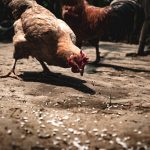Hawks are predatory birds that pose a significant threat to small animals, including chickens and other poultry. They possess sharp talons, keen eyesight, and swift flying abilities, which make them efficient hunters. Hawks are opportunistic predators, often targeting small animals that are easy to catch and carry.
They are capable of swooping down from the sky with remarkable speed and precision, making it challenging for their prey to escape. Hawks also employ stealthy hunting behavior, frequently observing from elevated positions such as trees or other high vantage points before striking. For poultry owners, the ability to identify hawks and understand their behavior is crucial for effectively protecting their flocks.
Recognizing signs of hawk presence, such as circling in the sky or perching in nearby trees, allows owners to implement proactive measures to deter these predators and ensure the safety of their poultry. Understanding the threat posed by hawks is essential for developing and implementing effective deterrents and protection strategies for a poultry flock. Hawks represent a common threat to poultry, and comprehending their behavior is vital for flock protection.
These predatory birds are characterized by their speed, agility, and stealthy hunting tactics. By identifying signs of hawk presence and understanding their behavior patterns, poultry owners can take appropriate measures to safeguard their flocks from these formidable hunters.
Table of Contents
- 1 Creating a Safe Environment: Implementing Physical Barriers and Deterrents
- 2 Utilizing Visual Deterrents: Scarecrows, Reflective Objects, and Decoys
- 3 Implementing Auditory Deterrents: Noisemakers and Predator Calls
- 4 Strategic Timing: Supervising Free Range Time and Providing Safe Shelter
- 5 Establishing a Flock Protection Plan: Training Guard Animals and Encouraging Flock Behavior
- 6 Seeking Professional Help: Consulting with Wildlife Experts and Bird Control Services
- 7 FAQs
- 7.1 What are some natural ways to keep hawks away from free range chickens?
- 7.2 Are there any commercial products available to deter hawks from free range chickens?
- 7.3 What should I do if I spot a hawk near my free range chickens?
- 7.4 Are there any legal methods to deter hawks from free range chickens?
- 7.5 What are some signs that a hawk has been targeting my free range chickens?
Key Takeaways
- Hawks can be identified by their behavior, such as circling overhead or swooping down on prey.
- Physical barriers like netting and fencing can help create a safe environment and deter hawks from attacking.
- Visual deterrents like scarecrows and reflective objects can help keep hawks away from your property.
- Noisemakers and predator calls can be effective auditory deterrents to scare off hawks.
- Supervising free range time and providing safe shelter can help protect your flock from hawk attacks.
Creating a Safe Environment: Implementing Physical Barriers and Deterrents
Physical Barriers: The First Line of Defense
One effective method of deterring hawks is to implement physical barriers around the chicken coop and run. This can include installing wire mesh fencing with a roof or cover to prevent hawks from swooping down and snatching up chickens. Additionally, placing netting or wire over the top of the run can provide an extra layer of protection against aerial attacks. By creating a secure and enclosed space for the poultry, owners can significantly reduce the risk of hawk predation.
Scare Tactics: Disrupting Hawk Behavior
In addition to physical barriers, there are other deterrents that can be implemented to create a safe environment for poultry. Scare tactics, such as hanging shiny objects or predator decoys around the coop and run, can help to deter hawks from approaching. These visual deterrents can disrupt the hawks’ hunting patterns and make them think twice about targeting the poultry.
A Comprehensive Approach to Hawk Deterrence
By implementing physical barriers and deterrents, poultry owners can create a safe environment for their flock and reduce the risk of hawk attacks. By combining these methods, owners can create a multi-layered defense system that protects their poultry from aerial predators.
Utilizing Visual Deterrents: Scarecrows, Reflective Objects, and Decoys

Visual deterrents can be highly effective in deterring hawks from targeting poultry. Scarecrows are a classic method of warding off birds, including hawks, by creating the illusion of a human presence in the area. Placing scarecrows in and around the chicken coop and run can help to deter hawks from approaching and reduce the risk of predation.
Additionally, hanging reflective objects such as CDs or aluminum foil strips around the coop can create flashes of light that may startle and deter hawks. Another visual deterrent that can be effective in deterring hawks is the use of predator decoys. These decoys mimic natural predators of hawks, such as owls or eagles, and can create a sense of danger for the hawks, causing them to avoid the area.
By utilizing visual deterrents such as scarecrows, reflective objects, and decoys, poultry owners can effectively deter hawks from targeting their flock and create a safer environment for their birds. Visual deterrents such as scarecrows, reflective objects, and decoys can be highly effective in deterring hawks from targeting poultry. Scarecrows create the illusion of a human presence in the area, which can deter hawks from approaching.
Hanging reflective objects such as CDs or aluminum foil strips around the coop can create flashes of light that may startle and deter hawks. Additionally, using predator decoys that mimic natural predators of hawks, such as owls or eagles, can create a sense of danger for the hawks, causing them to avoid the area. By utilizing these visual deterrents, poultry owners can effectively deter hawks from targeting their flock and create a safer environment for their birds.
Implementing Auditory Deterrents: Noisemakers and Predator Calls
In addition to visual deterrents, auditory deterrents can also be effective in deterring hawks from targeting poultry. Noisemakers such as air horns, whistles, or even banging pots and pans together can startle and scare off hawks when they approach the coop or run. The sudden loud noises disrupt the hawks’ hunting behavior and make them think twice about targeting the poultry.
By regularly using auditory deterrents when hawks are present, poultry owners can effectively discourage these predators from approaching their flock. Another effective auditory deterrent is the use of predator calls. These calls mimic the sounds of natural predators of hawks, such as owls or eagles, and can create a sense of danger for the hawks, causing them to avoid the area.
By strategically using auditory deterrents such as noisemakers and predator calls, poultry owners can effectively deter hawks from targeting their flock and reduce the risk of predation. Auditory deterrents such as noisemakers and predator calls can be effective in deterring hawks from targeting poultry. Noisemakers such as air horns, whistles, or banging pots and pans together can startle and scare off hawks when they approach the coop or run.
The sudden loud noises disrupt the hawks’ hunting behavior and make them think twice about targeting the poultry. Additionally, using predator calls that mimic the sounds of natural predators of hawks, such as owls or eagles, can create a sense of danger for the hawks, causing them to avoid the area. By strategically using auditory deterrents, poultry owners can effectively deter hawks from targeting their flock and reduce the risk of predation.
Strategic Timing: Supervising Free Range Time and Providing Safe Shelter
Supervising free range time for poultry is crucial for protecting them from hawk attacks. Allowing chickens to roam freely without supervision increases their vulnerability to hawk predation. By supervising free range time and keeping a close eye on the surroundings for any signs of hawk presence, poultry owners can quickly intervene and protect their flock from potential attacks.
Additionally, providing safe shelter options such as dense shrubbery or covered areas where chickens can seek refuge in case of a hawk sighting is essential for their safety. Strategic timing is also important when it comes to allowing free range time for poultry. Hawks are most active during certain times of day, such as early morning or late afternoon, so it is best to schedule free range time during periods when hawk activity is minimal.
By strategically supervising free range time and providing safe shelter options for poultry, owners can effectively protect their flock from hawk attacks and reduce the risk of predation. Supervising free range time for poultry is crucial for protecting them from hawk attacks. Allowing chickens to roam freely without supervision increases their vulnerability to hawk predation.
By keeping a close eye on the surroundings for any signs of hawk presence and providing safe shelter options such as dense shrubbery or covered areas where chickens can seek refuge in case of a hawk sighting, poultry owners can effectively protect their flock from potential attacks. Strategic timing is also important when it comes to allowing free range time for poultry. Hawks are most active during certain times of day, so it is best to schedule free range time during periods when hawk activity is minimal.
Establishing a Flock Protection Plan: Training Guard Animals and Encouraging Flock Behavior

Training Guard Animals
One effective method is to train guard animals such as dogs or geese to protect the flock from predators. These animals have natural protective instincts and can help deter hawks from approaching the poultry by patrolling the area and alerting owners to potential threats.
Encouraging Flock Behavior
Additionally, encouraging flock behavior such as staying close together and being vigilant against aerial predators can help reduce the risk of hawk attacks. By promoting a sense of unity and awareness among the flock, poultry owners can create an environment that is less appealing to hawks.
Providing Safe Shelter Options
Another important aspect of a flock protection plan is to provide adequate shelter options for poultry to seek refuge in case of a hawk sighting. This can include dense shrubbery or covered areas within the coop or run where chickens can hide from potential predators. By providing a safe haven, poultry owners can give their flock a better chance of survival in the event of a hawk attack.
By implementing these strategies, poultry owners can effectively protect their flock from hawk attacks and ensure a safe and healthy environment for their birds.
Seeking Professional Help: Consulting with Wildlife Experts and Bird Control Services
In some cases, dealing with hawk predation may require professional assistance from wildlife experts or bird control services. These professionals have specialized knowledge and experience in dealing with predatory birds such as hawks and can provide valuable insights and solutions for protecting poultry from attacks. Wildlife experts may offer advice on habitat modification techniques or other non-lethal methods of deterring hawks from targeting poultry.
Additionally, bird control services may offer specialized products or services designed to deter predatory birds from approaching residential areas or agricultural properties. These services may include installing bird netting or spikes on structures to prevent roosting or nesting, or using bird repellent sprays or sonic devices to discourage birds from entering an area. By consulting with wildlife experts and bird control services, poultry owners can gain access to professional assistance and resources for effectively managing hawk predation and protecting their flock.
Dealing with hawk predation may require professional assistance from wildlife experts or bird control services. These professionals have specialized knowledge and experience in dealing with predatory birds such as hawks and can provide valuable insights and solutions for protecting poultry from attacks. Wildlife experts may offer advice on habitat modification techniques or other non-lethal methods of deterring hawks from targeting poultry.
Additionally, bird control services may offer specialized products or services designed to deter predatory birds from approaching residential areas or agricultural properties. By consulting with these professionals, poultry owners can gain access to professional assistance and resources for effectively managing hawk predation and protecting their flock. In conclusion, protecting poultry from hawk predation requires a comprehensive approach that includes understanding the threat posed by hawks, implementing physical barriers and deterrents, utilizing visual and auditory deterrents, strategic timing for free range time, establishing a flock protection plan, and seeking professional help when necessary.
By recognizing the signs of hawk presence and understanding their behavior, poultry owners can take proactive measures to protect their flock from these formidable predators. Implementing physical barriers such as wire mesh fencing with a roof or cover, scarecrows, reflective objects, predator decoys, noisemakers, predator calls, supervising free range time, training guard animals, encouraging flock behavior, providing safe shelter options, and seeking professional assistance are all important components of an effective strategy for protecting poultry from hawk attacks. By taking these proactive measures and implementing a comprehensive protection plan that includes both preventative measures and responsive actions when necessary, poultry owners can effectively manage hawk predation and create a safer environment for their flock.
It is important for poultry owners to be vigilant in monitoring their surroundings for signs of hawk presence and take proactive steps to protect their birds from these formidable predators. With careful planning and strategic implementation of deterrents and protection measures, it is possible to minimize the risk of hawk attacks on poultry and ensure their safety and well-being.
If you’re looking for ways to protect your free range chickens from predators like hawks, you may also be interested in learning about how geese can help keep your chickens safe. According to a recent article on PoultryWizard, geese can be effective at deterring predators and can even eat the same feed as chickens. To learn more about how geese can protect your chickens, check out this article.
FAQs
What are some natural ways to keep hawks away from free range chickens?
Some natural ways to keep hawks away from free range chickens include providing overhead cover such as trees or netting, using scare tactics like reflective objects or noise makers, and keeping a rooster with the flock to alert the hens of potential danger.
Are there any commercial products available to deter hawks from free range chickens?
Yes, there are commercial products available such as hawk decoys, predator eye balloons, and electronic deterrents that emit sounds to scare away hawks.
What should I do if I spot a hawk near my free range chickens?
If you spot a hawk near your free range chickens, it’s important to take immediate action to protect your flock. You can use scare tactics, such as making loud noises or waving your arms, to try to scare the hawk away. It’s also a good idea to provide overhead cover for your chickens to give them a safe place to hide.
Are there any legal methods to deter hawks from free range chickens?
In the United States, hawks are protected under the Migratory Bird Treaty Act, so it is illegal to harm or kill them. However, there are legal methods to deter hawks from free range chickens, such as using scare tactics and providing overhead cover for the chickens.
What are some signs that a hawk has been targeting my free range chickens?
Some signs that a hawk has been targeting your free range chickens include finding feathers or remains of chickens in the area, seeing a hawk circling overhead, or noticing that your chickens are acting skittish or staying close to cover.
Meet Walter, the feathered-friend fanatic of Florida! Nestled in the sunshine state, Walter struts through life with his feathered companions, clucking his way to happiness. With a coop that’s fancier than a five-star hotel, he’s the Don Juan of the chicken world. When he’s not teaching his hens to do the cha-cha, you’ll find him in a heated debate with his prized rooster, Sir Clucks-a-Lot. Walter’s poultry passion is no yolk; he’s the sunny-side-up guy you never knew you needed in your flock of friends!







